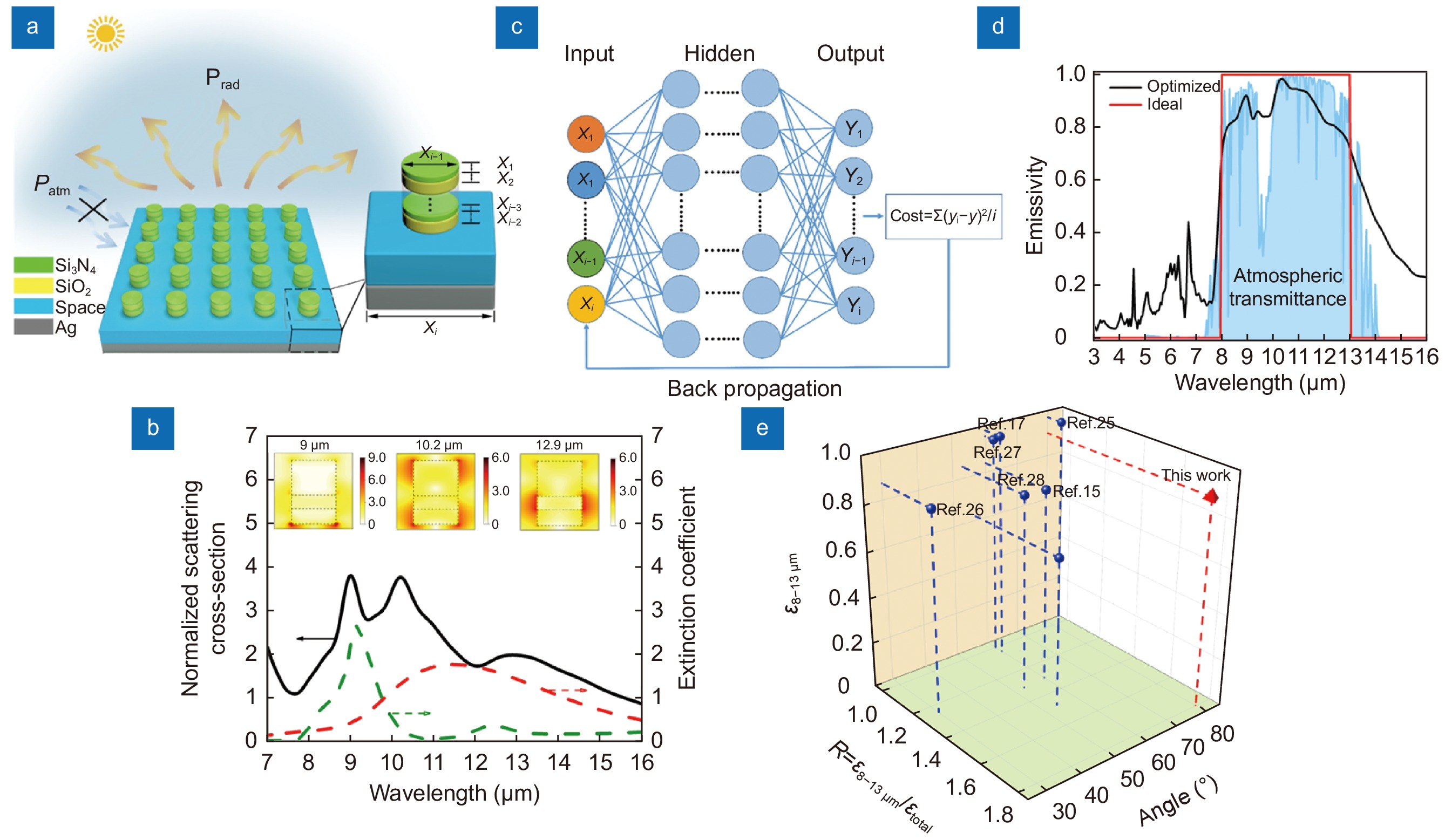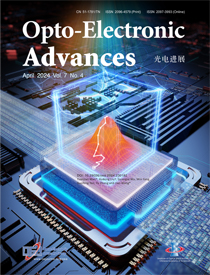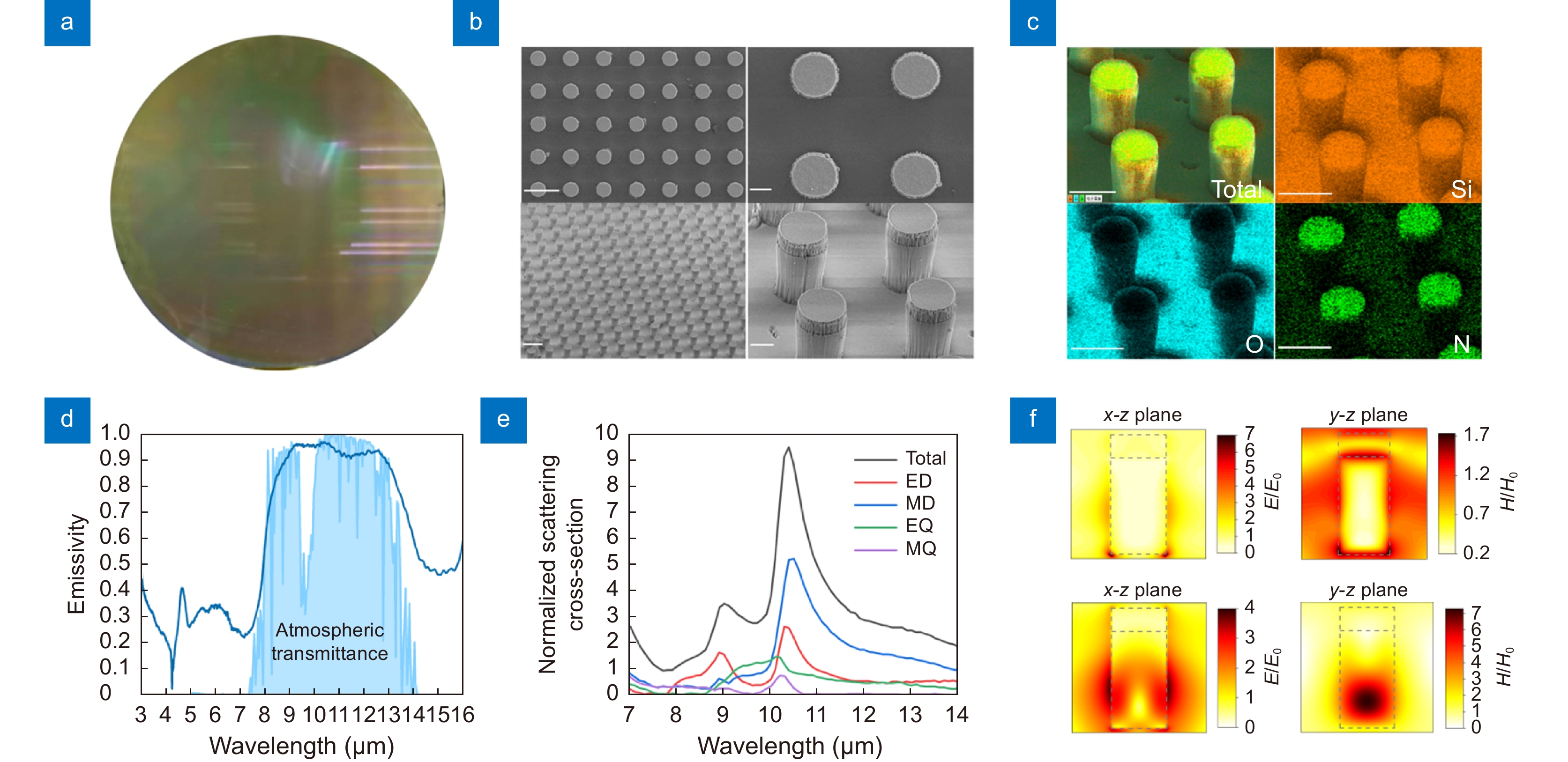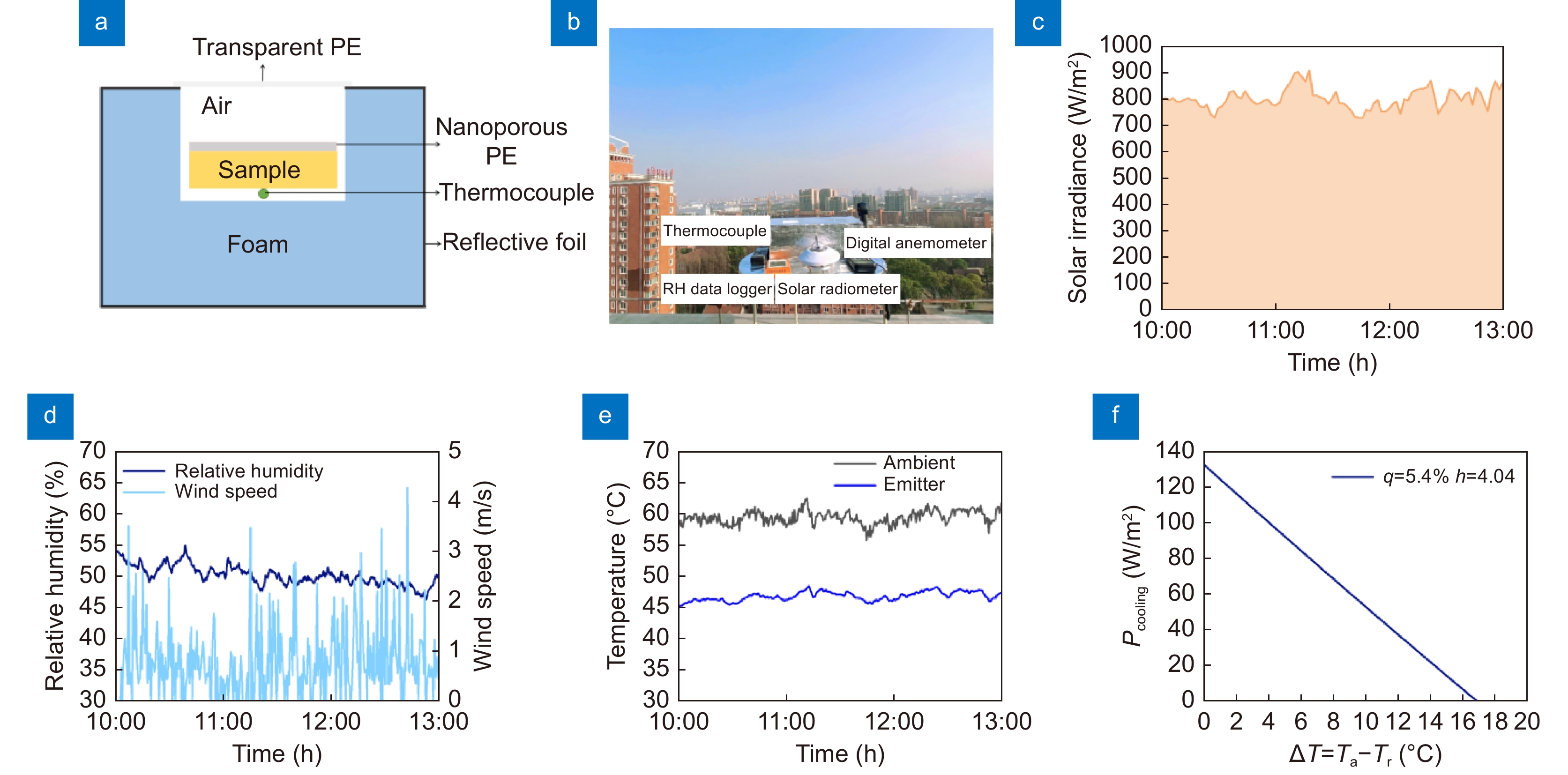| Citation: | Zhang YN, Chen YG, Wang T et al. Ultrahigh performance passive radiative cooling by hybrid polar dielectric metasurface thermal emitters. Opto-Electron Adv 7, 230194 (2024). doi: 10.29026/oea.2024.230194 |
Ultrahigh performance passive radiative cooling by hybrid polar dielectric metasurface thermal emitters
-
Abstract
Real-world passive radiative cooling requires highly emissive, selective, and omnidirectional thermal emitters to maintain the radiative cooler at a certain temperature below the ambient temperature while maximizing the net cooling power. Despite various selective thermal emitters have been demonstrated, it is still challenging to achieve these conditions simultaneously because of the extreme difficulty in controlling thermal emission of photonic structures in multidimension. Here we demonstrated hybrid polar dielectric metasurface thermal emitters with machine learning inverse design, enabling a high emissivity of ~0.92 within the atmospheric transparency window 8–13 μm, a large spectral selectivity of ~1.8 and a wide emission angle up to 80 degrees, simultaneously. This selective and omnidirectional thermal emitter has led to a new record of temperature reduction as large as ~15.4 °C under strong solar irradiation of ~800 W/m2, significantly surpassing the state-of-the-art results. The designed structures also show great potential in tackling the urban heat island effect, with modelling results suggesting a large energy saving and deployment area reduction. This research will make significant impact on passive radiative cooling, thermal energy photonics and tackling global climate change.-
Keywords:
- radiative cooling /
- dielectric metasurfaces /
- machine learning /
- thermal emitters
-

-
References
[1] Raman AP, Anoma MA, Zhu LX et al. Passive radiative cooling below ambient air temperature under direct sunlight. Nature 515, 540–544 (2014). doi: 10.1038/nature13883 [2] Zhang YN, Chen X, Cai BY et al. Photonics empowered passive radiative cooling. Adv Photon Res 2, 2000106 (2021). doi: 10.1002/adpr.202000106 [3] Yin XB, Yang RG, Tan G et al. Terrestrial radiative cooling: using the cold universe as a renewable and sustainable energy source. Science 370, 786–791 (2020). doi: 10.1126/science.abb0971 [4] Fan SH, Li W. Photonics and thermodynamics concepts in radiative cooling. Nat Photonics 16, 182–190 (2022). doi: 10.1038/s41566-021-00921-9 [5] Li T, Zhai Y, He SM et al. A radiative cooling structural material. Science 364, 760–763 (2019). doi: 10.1126/science.aau9101 [6] Zeng SN, Pian SJ, Su MY et al. Hierarchical-morphology metafabric for scalable passive daytime radiative cooling. Science 373, 692–696 (2021). doi: 10.1126/science.abi5484 [7] So S, Yun J, Ko B et al. Radiative cooling for energy sustainability: from fundamentals to fabrication methods toward commercialization. Adv Sci 11, 2305067 (2024). doi: 10.1002/advs.202305067 [8] Rephaeli E, Raman A, Fan SH. Ultrabroadband photonic structures to achieve high-performance daytime radiative cooling. Nano Lett 13, 1457–1461 (2013). doi: 10.1021/nl4004283 [9] Hossain M, Jia BH, Gu M. A metamaterial emitter for highly efficient radiative cooling. Adv Opt Mater 3, 1047–1051 (2015). doi: 10.1002/adom.201500119 [10] Zhu LX, Raman AP, Fan SH. Radiative cooling of solar absorbers using a visibly transparent photonic crystal thermal blackbody. Proc Natl Acad Sci USA 112, 12282–12287 (2015). doi: 10.1073/pnas.1509453112 [11] Zhai Y, Ma YG, David SN et al. Scalable-manufactured randomized glass-polymer hybrid metamaterial for daytime radiative cooling. Science 355, 1062–1066 (2017). doi: 10.1126/science.aai7899 [12] Wang T, Zhang YA, Chen M et al. Scalable and waterborne titanium-dioxide-free thermochromic coatings for self-adaptive passive radiative cooling and heating. Cell Rep Phys Sci 3, 100782 (2022). doi: 10.1016/j.xcrp.2022.100782 [13] Gentle AR, Smith GB. Radiative heat pumping from the earth using surface phonon resonant nanoparticles. Nano Lett 10, 373–379 (2010). doi: 10.1021/nl903271d [14] Chen Z, Zhu LX, Raman A et al. Radiative cooling to deep sub-freezing temperatures through a 24-h day–night cycle. Nat Commun 7, 13729 (2016). doi: 10.1038/ncomms13729 [15] Li W, Shi Y, Chen Z et al. Photonic thermal management of coloured objects. Nat Commun 9, 4240 (2018). doi: 10.1038/s41467-018-06535-0 [16] Chae D, Kim M, Jung PH et al. Spectrally selective inorganic-based multilayer emitter for daytime radiative cooling. ACS Appl Mater Interfaces 12, 8073–8081 (2020). doi: 10.1021/acsami.9b16742 [17] Yao KQ, Ma HC, Huang M et al. Near-perfect selective photonic crystal emitter with nanoscale layers for daytime radiative cooling. ACS Appl Nano Mater 2, 5512–5519 (2019). [18] Mandal J, Fu YK, Overvig AC et al. Hierarchically porous polymer coatings for highly efficient passive daytime radiative cooling. Science 362, 315–319 (2018). doi: 10.1126/science.aat9513 [19] Zou CJ, Ren GH, Hossain M et al. Metal-loaded dielectric resonator metasurfaces for radiative cooling. Adv Opt Mater 5, 1700460 (2017). doi: 10.1002/adom.201700460 [20] Sun K, Riedel CA, Wang YD et al. Metasurface optical solar reflectors using AZO transparent conducting oxides for radiative cooling of spacecraft. ACS Photonics 5, 495–501 (2018). doi: 10.1021/acsphotonics.7b00991 [21] Zhu RK, Hu DW, Chen Z et al. Plasmon-enhanced infrared emission approaching the theoretical limit of radiative cooling ability. Nano Lett 20, 6974–6980 (2020). doi: 10.1021/acs.nanolett.0c01457 [22] Munday JN. Tackling climate change through radiative cooling. Joule 3, 2057–2060 (2019). doi: 10.1016/j.joule.2019.07.010 [23] Zhou L, Song HM, Liang JW et al. A polydimethylsiloxane-coated metal structure for all-day radiative cooling. Nat Sustain 2, 718–724 (2019). doi: 10.1038/s41893-019-0348-5 [24] Heo SY, Lee GJ, Kim DH et al. A Janus emitter for passive heat release from enclosures. Sci Adv 6, eabb1906 (2020). doi: 10.1126/sciadv.abb1906 [25] Tang KC, Dong KC, Li JC et al. Temperature-adaptive radiative coating for all-season household thermal regulation. Science 374, 1504–1509 (2021). doi: 10.1126/science.abf7136 [26] Wang T, Wu Y, Shi L et al. A structural polymer for highly efficient all-day passive radiative cooling. Nat Commun 12, 365 (2021). doi: 10.1038/s41467-020-20646-7 [27] Ma HC, Yao KQ, Dou SL et al. Multilayered SiO2/Si3N4 photonic emitter to achieve high-performance all-day radiative cooling. Solar Energy Mater Solar Cells 212, 110584 (2020). doi: 10.1016/j.solmat.2020.110584 [28] Wang X, Liu XH, Li ZY et al. Scalable flexible hybrid membranes with photonic structures for daytime radiative cooling. Adv Funct Mater 30, 1907562 (2020). doi: 10.1002/adfm.201907562 [29] Lin CJ, Li Y, Chi C et al. A solution-processed inorganic emitter with high spectral selectivity for efficient subambient radiative cooling in hot humid climates. Adv Mater 34, 2109350 (2022). doi: 10.1002/adma.202109350 [30] Kim M, Lee D, Son S et al. Visibly transparent radiative cooler under direct sunlight. Adv Opt Mater 9, 2002226 (2021). doi: 10.1002/adom.202002226 [31] Lee D, Go M, Son S et al. Sub-ambient daytime radiative cooling by silica-coated porous anodic aluminum oxide. Nano Energy 79, 105426 (2021). doi: 10.1016/j.nanoen.2020.105426 [32] Qin B, Zhu YN, Zhou YW et al. Whole-infrared-band camouflage with dual-band radiative heat dissipation. Light Sci Appl 12, 246 (2023). doi: 10.1038/s41377-023-01287-z [33] Yun J, Chae D, So S et al. Optimally designed multimaterial microparticle–polymer composite paints for passive daytime radiative cooling. ACS Photonics 10, 2608–2617 (2023). doi: 10.1021/acsphotonics.3c00339 [34] Zhu YN, Zhou YW, Qin B et al. Night-time radiative warming using the atmosphere. Light Sci Appl 12, 268 (2023). doi: 10.1038/s41377-023-01315-y [35] Wang T, Wu XY, Zhu Q et al. A scalable and durable polydimethylsiloxane-coated nanoporous polyethylene textile for daytime radiative cooling. Nanophotonics,doi: 10.1515/nanoph-2023-0596. [36] Wang T, Tu SH, Chen YG et al. Scalable and flexible porous hybrid film as a thermal insulating subambient radiative cooler for energy-saving buildings. Natl Sci Open 2, 20220063 (2023). doi: 10.1360/nso/20220063 [37] Hossain M, Gu M. Radiative cooling: principles, progress, and potentials. Adv Sci 3, 1500360 (2016). doi: 10.1002/advs.201500360 [38] Zhang YA, Han J, Shi L et al. Extremely polarized and efficient hot electron intraband luminescence from aluminum nanostructures for nonlinear optical encoding. Laser Photon Rev 15, 2000339 (2021). doi: 10.1002/lpor.202000339 [39] Neshev DN, Miroshnichenko AE. Enabling smart vision with metasurfaces. Nat Photonics 17, 26–35 (2023). [40] Guo R, Rusak E, Staude I et al. Multipolar coupling in hybrid metal–dielectric metasurfaces. ACS Photonics 3, 349–353 (2016). doi: 10.1021/acsphotonics.6b00012 [41] Barreda Á, Vitale F, Minovich AE et al. Applications of hybrid metal-dielectric nanostructures: state of the art. Adv Photonics Res 3, 2100286 (2022). doi: 10.1002/adpr.202100286 [42] Zhang YA, Shi L, Hu DJ et al. Full-visible multifunctional aluminium metasurfaces by in situ anisotropic thermoplasmonic laser printing. Nanoscale Horiz 4, 601–609 (2019). doi: 10.1039/C9NH00003H [43] Peurifoy J, Shen YC, Jing L et al. Nanophotonic particle simulation and inverse design using artificial neural networks. Sci Adv 4, eaar4206 (2018). doi: 10.1126/sciadv.aar4206 [44] Zhang QM, Yu HY, Barbiero M et al. Artificial neural networks enabled by nanophotonics. Light Sci Appl 8, 42 (2019). doi: 10.1038/s41377-019-0151-0 [45] Ren HR, Shao W, Li Y et al. Three-dimensional vectorial holography based on machine learning inverse design. Sci Adv 6, eaaz4261 (2020). doi: 10.1126/sciadv.aaz4261 [46] Ma W, Liu ZC, Kudyshev ZA et al. Deep learning for the design of photonic structures. Nat Photonics 15, 77–90 (2021). doi: 10.1038/s41566-020-0685-y [47] Jiang JQ, Chen MK, Fan JA. Deep neural networks for the evaluation and design of photonic devices. Nat Rev Mater 6, 679–700 (2021). [48] Zhao DL, Aili A, Zhai Y et al. Subambient cooling of water: toward real-world applications of daytime radiative cooling. Joule 3, 111–123 (2019). doi: 10.1016/j.joule.2018.10.006 [49] Hinkel KM, Nelson FE, Klene AE et al. The urban heat island in winter at Barrow, Alaska. Int J Climatol 23, 1889–1905 (2003). doi: 10.1002/joc.971 [50] Calculation parameters of outdoor air. http://www.jianbiaoku.com/webarbs/book/16582/1663640.shtml. [51] Chen X, Wang YW. Calculation and analysis of anthropogenic heat flux in provinces of China from 2001 to 2009. In The 28th Annual Meeting of the Chinese Meteorological Society - S7 City Meteorological Fine Forecasting and Services 490–505 (Chinese Meteorological Society, 2011). -
Supplementary Information
Supplementary information for Ultrahigh performance passive radiative cooling by hybrid polar dielectric metasurface thermal emitters 
-
Access History

Article Metrics
-
Figure 1.
Design of hybrid polar dielectric metasurface thermal emitter. (a) The proposed hybrid metasurface with the unit consisting of alternating Si3N4 and SiO2 polar dielectric materials. Patm is the downward atmosphere thermal emission and Prad is the thermal emission of the metasurfaces. (b) The normalized scattering cross-section of the optimized 3-layer (SiO2/Si3N4/SiO2) Mie resonator with the electrical field distributions at various resonance wavelengths and the extinction coefficients of Si3N4 (red) and SiO2 (green). (c) Schematic of the multilayer perception neural network for inverse design with input, hidden and output layers. (d) Emissivity spectrum of the inversely optimized 3-layer selective thermal emitter, compared with the ideal spectrum. (e) Emissivity, selectivity, and emission angle of this work, in comparison with state-of-the-art results.
-
Figure 2.
The fabricated 2-layer metasurface and its emissivity. (a) A photography of the fabricated 4 inches metasurface thermal emitter. (b) Top-view and tilted SEM images of an array of the hybrid SiO2/Si3N4 dielectric resonators (scale bar: 10 μm and 2 μm for the left and right two figures, respectively). (c) Energy-dispersive X-ray spectroscopy elemental mappings of the metasurfaces (scale bar: 5 μm). (d) The measured infrared emissivity of the metasurfaces. (e) Multipolar decomposition of the 2-layer dielectric resonator. ED: electrical dipole; MD: magnetic dipole; EQ: electric quadrupole; MQ: magnetic quadrupole. (f) Electric and magnetic field profiles at the two resonance wavelengths 8.9 μm (top) and 10.5 μm (bottom).
-
Figure 3.
Angle-resolved thermal emissivity. (a, b) Net cooling power
Pcooling of the ideal selective thermal emitter with various thermal emission angles in the cases of heat exchange coefficient h = 0 W/m2/K (a) and 2 W/m2/K (b). Ta and Tr are ambient and radiative cooler temperature, respectively. (c) The steady temperature of the radiative cooler as a function of the emission angle for various heat exchange coefficients h. (d–f) The angle-resolved emissivity (unpolarized, s polarized, and p polarized) of the metasurface thermal emitter. -
Figure 4.
(a) Schematic of the apparatus and the metasurface radiative cooler. (b) Photo of the apparatus on the test rooftop in Shanghai, China. (c, d) The solar irradiation and environment (wind speed and relative humidity) during the rooftop test. (e) Steady-state temperature of the metasurface radiative cooler and the ambient temperature. (f) The net cooling power of the radiative cooler using the experimental spectra data (solar absorbance: q=5.4%; heat exchange coefficient: h=4.04 W/m2/K).
-
Figure 5.
(a) Schematic diagram of the urban heat island effect. The ~N W/m2 represents the net growth rate of the anthropogenic heat. (b) The calculated deployment area to reduce the temperature by our metasurface radiative cooler with emission angle of 80° and 60°, respectively. (c–f) The calculated area for eliminating the heat island effect and achieving a comfortable body temperature during summertime for China’s four big cities: Beijing, Shanghai, Chongqing, and Tianjin.

 E-mail Alert
E-mail Alert RSS
RSS



 DownLoad:
DownLoad:






